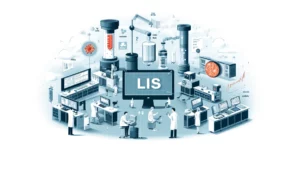
What is a Laboratory Information System: Functions and Applications
The laboratory information system (LIS) is integral to any laboratory’s workflow and data management. It tracks, consolidates, stores, and updates clinical details about patients in its database for the foreseeable future.
LIS is an integral part of any Lab operations, with lab technicians and healthcare providers using it to coordinate inpatient, outpatient, and point-of-care medical testing. LIS can assist during sample creation, testing, and reporting, with generated data playing a vital role in enhancing patient outcomes, developing clinical insights, and improving healthcare efficiency.
What is a Laboratory Information System?
The laboratory information system is a software, operating systems, and hardware collection that receives, processes, records, consolidates, and stores information generated by laboratory workflow. It acts as a command center, seamlessly integrating workflow processes like sample collection, processing, testing, and reporting.
An LIS eliminates the need for manual record-keeping and serves as a centralized warehouse for specimen and patient data. Thus, safeguarding the accuracy, traceability, and accessibility of all data captured. The data captured and processed by an LIS reduces the turnaround time of laboratory tests and significantly reduces human error while maintaining compliance with regulatory standards.
Components of an LIS system
The LIS requires three different components to work simultaneously to ensure the system functions as needed. These components are:
- Tracking sample: This is the main component of an LIS, as samples are the most valuable assets of any clinical laboratory. Having the details of samples in an electronic format ensures that they reach their analysis destination in different parts of the laboratory. Sample trackers then generate concise results of all tests performed from the sample in a single document.
- Implementation of protocol: Another vital component of an LIS is the implementation of protocols, procedures, and best practices to improve laboratory workflow standards. LIS helps generate SOPs for processing samples and result interpretation, ensuring the laboratory maintains consistency. The LIS also provides stringent protocols for maintaining quality tests, generates concise results, and distributes the results per requirements.
- Storage: The final essential component of an LIS is managing sample storage for present and future use. The system tracks the batch, container, shelf rack, freezer, or storage area, providing laboratories with efficient sample location.
Other components of an optimal and credible LIS include:
- Information security
- Analytic phase
- Data mining and cross-sectional reports
- Quality management
- Result entry and validation
- Administrative and Financial
- Scalability (e.g., fit a single or multi-site laboratory)
- Multi-specialty reporting
- Interoperability
- Automated process
How does LIS software work?
The LIS is needed at each step of the laboratory testing process, with information flowing to and from the laboratory. A general laboratory workflow includes pre-analysis, analysis, and post-analysis:
- The pre-analytical workflow includes login to the software, sample tracking, and chemical and reagent inventory.
- Analytical workflow includes schedule testing, chain of custody, instrument integration, result entry, and QC/QA specimen checking.
- Post-analytical workflow includes reporting results and archiving data.
At each of the laboratory workflow’s three steps, the LIS tracks and records items such as clinical history, clinical identifiers, patient demographics, block information, slide information, diagnosis, and other essential data.
There are many different LIS software available on the market today, from bare-bones systems to cloud-based LIS software (cloud-hosted and SaaS). The adoption of cloud-based LIS solutions provides laboratories with remote access and scalability, facilitating collaboration across organizations. Laboratories with cloud-based LIS solutions also avoid the unnecessary hassle of maintaining on-premises software.
The Functions and Features of Laboratory Information Systems
The core function of an LIS is to provide a more efficient support system for the processing of laboratory tests by reducing manual work and transcription errors. The basic functions of a LIS include:
- Timely access to patient data for personalized medicine
- Improved communication channels and resource management
- Electronic data exchange and real-time specimen tracking
- Customizable reporting and decision support capabilities
- Organized experimental data for expedited research
An LIS has many notable features, such as:
- Quality control assessments
- Inventory tracking
- Data management and storage
- Strict compliance with SOP guidelines
- Sample registration and monitoring
- Detailed reports and analytics
- Equipment integrations
- Workflow management
The features and functions of an LIS provide laboratories with the following benefits:
- Improve the quality of data produced.
- Optimize the efficiency of laboratory operations for improved healthcare delivery.
- Connect with patient registration, billing systems, and electronic health records (EHR). while maintaining HIPAA compliance.
- Providing healthcare professionals and patients with accurate and timely results.
- Assist in the decision-making of health professionals for the promotion, diagnosis, treatment, and management of health.
- Automate processes thus saving precious time.
Applications of Laboratory Information Systems
LIS is critical to the healthcare ecosystem, providing a digital framework for managing laboratory workflows and patient data. As laboratory tests provide the majority of information needed for clinical decision-making, streamlining and automating laboratory processes has significantly improved laboratory test throughput while reducing turnaround times and ensuring that healthcare providers have timely access to patient data and critical results to improve clinical outcomes and patient care.
Many laboratories and institutions have elected to interface their EHRs with their LIS, significantly improving turnaround times through a seamless flow of data across healthcare organizations and services. EHRs proved the ability to follow patient data longitudinally, increase provider-patient interactions, and improve cost savings.
Reported benefits of EHRs interfaced with LIS may include:
- Integrate data from other laboratory software systems (LSS)
- Allow easier access to patient data
- Automate laboratory workflow management
- Create reports by analyzing generated data
- Support laboratory equipment and supplies management
- Facilitate on-demand access to reports for physicians
- Ensure reliable sample tracking and lab results
- Improve efficiency for laboratory billing processes
- Providing enhanced collaboration and reducing the risk of errors
Future applications include the adoption and integration of artificial intelligence, machine learning, and predictive analytics. This will enhance healthcare providers’ ability to incorporate precision medicine, leading to improved patient outcomes and efficiency in healthcare.
In Conclusion
An LIS is an essential flexible tool that streamlines efficiency and reduces the occurrence of laboratory errors. It achieves this by automating the lab’s workflow, allowing the lab to provide faster turnaround while adhering to strict SOPs. LIS also helps to improve a laboratory’s reliability and quality.




